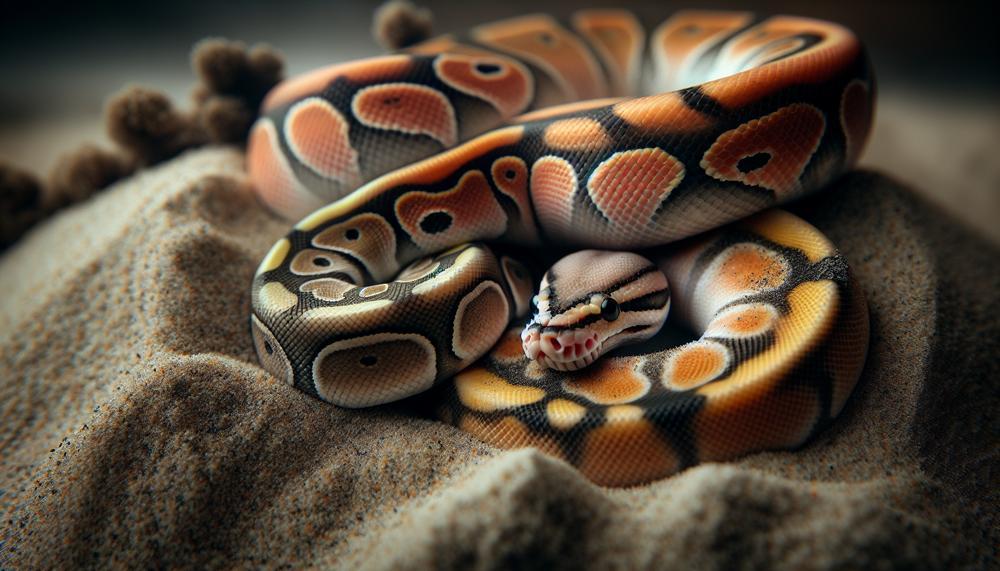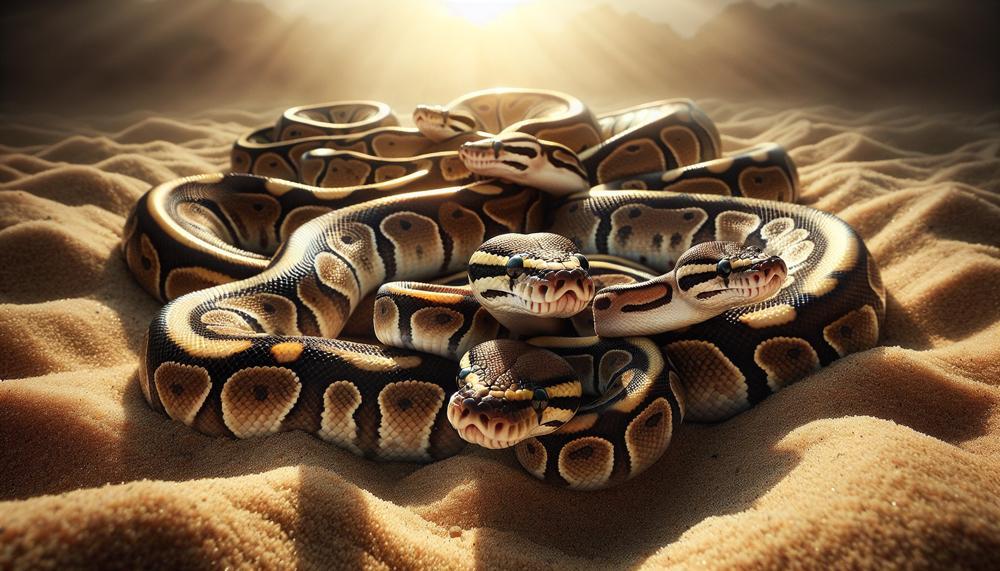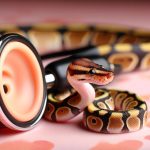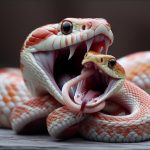Are you considering a ball python as your next pet? These captivating creatures have gained popularity in the reptile world for their gentle nature and low maintenance care. But when it comes to creating the perfect home for your scaly friend, one question often arises: do ball pythons like sand?
No, ball pythons should not use sand. Sand can be dangerous for snakes in several ways:
- Irritation: Silica sand and play sand can irritate a snake’s eyes, nasal passages, and skin between scales.
- Non-absorbent: Sand is non-absorbent, which can lead to bacteria growth that can cause disease and offensive odors.
- Internal injuries: If ingested, indigestible sand can cause internal injuries and impaction.
Ball pythons are happiest when housed on a loose substrate that mimics their natural habitat. This substrate should be readily available, easy to spot clean, and facilitate moderate to high humidity levels. Natural soil is generally best for meeting these needs. You can provide a substrate layer that is a minimum of 2-4 inches deep.
By the end of this post, you’ll have a better understanding of whether or not sand bedding is the right choice for your ball python’s enclosure.
So let’s slither on in and find out if these serpents truly enjoy sand or if it’s just a slippery slope to trouble.
Contents
Top 6 Best Substrates for Ball Pythons
After conducting thorough research and drawing from personal experience, we have curated a list of the top 6 best substrates for ball pythons.
These include natural soil, dried leaf litter, sphagnum moss, cypress mulch, orchid bark, and bioactive bedding. Each substrate offers distinct advantages and disadvantages for your snake.
Natural Soil:
Benefits:
- Provides a comfortable resting surface for the snake.
- Retains humidity to assist with shedding.
- Allows for natural burrowing behavior.
- Non-toxic and safe for your snake.
Drawbacks:
- May harbor harmful bacteria if not properly maintained.
- Can be cumbersome to clean and replace regularly.
Dried Leaf Litter:
Benefits:
- Mimics the natural environment of ball pythons.
- Encourages natural behaviors like burrowing and hiding.
- Retains humidity effectively.
- Non-toxic and safe for your snake.
Drawbacks:
- Requires regular replacement as it decomposes.
- May contain harmful bacteria if not properly maintained.
Sphagnum Moss:
Benefits:
- Retains humidity to promote proper shedding.
- Offers a soft and comfortable resting surface for your snake.
- Contains natural antibacterial properties.
- Non-toxic and safe for your snake.
Drawbacks:
- Needs to be replaced regularly as it decomposes.
- May be ingested by your snake if not closely monitored.
Cypress Mulch:
Benefits:
- Maintains humidity levels effectively.
- Assists with controlling odors.
- Non-toxic and safe for your snake.
Drawbacks:
- May contain sharp pieces that can harm your snake’s skin or eyes.
- Requires regular replacement as it breaks down.
Orchid Bark:
Benefits:
- Retains humidity effectively.
- Provides a natural look and feel.
- Non-toxic and safe for your snake.
Drawbacks:
- May contain sharp pieces that can harm your snake’s skin or eyes.
- Needs to be replaced regularly as it breaks down.
Bioactive Bedding:
Benefits:
- Creates a self-sustaining ecosystem for your snake.
- Encourages natural behaviors and reduces stress.
- Helps maintain humidity levels.
- Non-toxic and safe for your snake.
Drawbacks:
- Requires advanced knowledge and effort to set up and maintain.
- Can be costly to establish initially.
- May not be suitable for all types of snakes.
So, while each substrate has its own unique set of advantages and disadvantages, it is crucial to select one that is safe, comfortable, and promotes natural behaviors for your ball python.
It is also essential to regularly clean and replace the substrate to ensure the health and well-being of your snake. Avoid substrates that contain cedar as it can be harmful to snakes.
What to Look for When Purchasing Substrate for Ball Pythons
When it comes to selecting substrate for your ball python, there are several important factors to take into consideration. These include the humidity levels of the substrate, the potential risk of impaction, and the natural behavior of the snake. Choosing the right substrate is crucial for maintaining the overall health of your ball python.
The first factor to keep in mind is humidity levels. Ball pythons require a certain level of moisture in their environment to stay healthy. Therefore, it is essential to choose a substrate that can retain moisture and maintain appropriate humidity levels for your snake. This will help prevent any respiratory issues or skin problems that can arise from a lack of humidity.
Another important consideration is the risk of impaction. This occurs when a snake accidentally ingests its substrate, causing blockages in their digestive system. To avoid this, it is best to avoid substrates that are too small or dusty, as these can be easily swallowed by your ball python. It is also wise to steer clear of substrates made from materials that are difficult to digest, such as sand or gravel.
Lastly, you want to choose a substrate that allows your ball python to exhibit its natural burrowing behavior without any harmful effects. Ball pythons are known for their love of burrowing, and having a suitable substrate will allow them to engage in this behavior without causing any irritation or harm.

Substrates to Avoid for Ball Pythons
When it comes to keeping ball pythons as pets, there are certain substrates that should be avoided at all costs. These include sand, cedar shavings, and newspaper. While they may seem like harmless options, these substrates can actually pose serious threats to your snake’s health and well-being.
- One major issue with these substrates is the risk of impaction. This occurs when the snake ingests small particles of the substrate, which can then become lodged in their digestive tract. This can lead to serious health problems and may even require medical intervention.
- Additionally, sand and cedar shavings can also cause respiratory problems for ball pythons. The dust from these substrates can irritate their sensitive respiratory systems, leading to coughing, wheezing, and difficulty breathing. This is especially dangerous for young or sick snakes.
- Moreover, using these substrates can also cause skin irritation for ball pythons. When they burrow or move around on rough surfaces like sand or cedar shavings, it can cause scratches and abrasions on their delicate scales. This not only causes discomfort for the snake but can also increase their risk of infection.
- Lastly, using unsuitable substrates can also cause stress for your pet ball python. They may feel uncomfortable and unable to behave naturally, which can lead to a decline in their overall well-being.
Safe Substrates for Ball Pythons
When it comes to choosing the right substrate for your ball python, there are various options available, each with its own unique advantages and disadvantages.
Some of the most popular choices among snake owners include bioactive bedding, cypress mulch, coconut coir, orchid bark, and paper.
While all of these substrates are considered safe and comfortable for your pet, they differ in terms of maintenance, cost, and suitability for different sizes and ages of ball pythons.
Bioactive Bedding
Bioactive bedding is widely considered the top choice for ball pythons as it closely mimics their natural habitat and provides a low-maintenance option once properly set up.
This type of substrate contains live insects that help break down waste and maintain a healthy environment for your snake. It also features a built-in drainage system that helps regulate humidity levels in the enclosure.
Cypress Mulch
Another popular and safe substrate option for ball pythons is cypress mulch. It offers a natural look for your snake’s enclosure and is easy to clean and maintain, making it a great alternative for those who do not want to invest in bioactive bedding.
Coconut Coir/Fiber/Husk/Chips
Substrates made from coconut products are known for their ability to hold humidity well, making them a great choice for ball pythons that require high humidity levels. They also provide a safe option for burrowing.
However, they may not be suitable for larger ball pythons as they may ingest the substrate while hunting for food.
Orchid Bark
Orchid bark is another popular choice among snake owners due to its dust-free nature and ease of cleaning.
However, it may not be ideal for young ball pythons who may accidentally ingest it while exploring their enclosure.
Paper
For those on a budget, paper substrates such as newspaper or butcher’s paper are a great option.
They can be easily replaced when soiled and are the most cost-effective choice among all the substrates. However, they may require more frequent changing due to the high humidity levels in the enclosure.
Bedding Maintenance for Ball Pythons
When it comes to bedding for your ball python, there are a few suitable options to choose from. These include aspen shavings, cypress mulch, and paper towels or newspaper. However, one type of bedding that should always be avoided is sand. Despite its availability and low cost, sand can pose significant health risks to your reptile friend.
To keep your ball python’s enclosure clean and hygienic, it is important to spot clean the bedding daily. This involves removing any soiled areas and replacing them with fresh bedding. For aspen shavings and cypress mulch, a full enclosure cleaning should be done every 2-3 months. This ensures that your ball python has a clean and comfortable living space.
For those using paper towels or newspaper as bedding, spot cleaning can be done daily while a full enclosure cleaning should be done weekly. These types of bedding are easier to clean and replace compared to aspen shavings and cypress mulch, making them a convenient option for busy snake owners.
Also Read: Why Is My Corn Snake Shedding Too Often?
Conclusion
In conclusion, while sand may initially seem like a suitable substrate for ball pythons, it can actually have detrimental effects on their health.
The potential risks of impaction and skin irritation, as well as the difficulty in maintaining proper humidity levels, make sand a less than ideal option for these gentle creatures. Through extensive research and personal experience, we have compiled a list of the top 6 best substrates for ball pythons: natural soil, dried leaf litter, sphagnum moss, cypress mulch, orchid bark, and bioactive bedding.
It is crucial to prioritize your snake’s safety by providing a substrate that promotes its natural behavior and overall health. Regular cleaning and disinfecting of the enclosure are also vital for creating a healthy environment.
Sand should always be avoided to prevent harm to your beloved pet.






